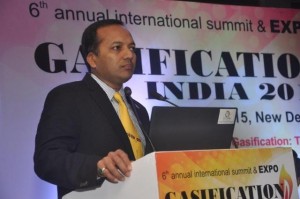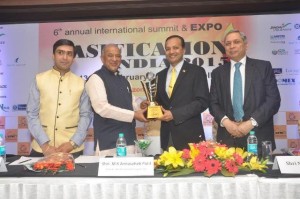 Jindal Steel and Power Limited (JSPL) becomes the first company to build the first-of-its-kind Coal Gasification plant in India and the first in the world where gas from coal is used to produce DRI. JSPL stressed the need for India to explore alternate ways of obtaining gas to help attain energy security, while showcasing its unique, state-of-the-art Coal-to-Gas plant at Angul, Odisha at the recently held; 6th International summit on Gasification and its Applications, GASIFICATION INDIA: 2015.
Jindal Steel and Power Limited (JSPL) becomes the first company to build the first-of-its-kind Coal Gasification plant in India and the first in the world where gas from coal is used to produce DRI. JSPL stressed the need for India to explore alternate ways of obtaining gas to help attain energy security, while showcasing its unique, state-of-the-art Coal-to-Gas plant at Angul, Odisha at the recently held; 6th International summit on Gasification and its Applications, GASIFICATION INDIA: 2015.
Worldwide, gasification has reliably gained a good share in the past few decades, as there is a rise in chemical, energy, and natural gas demand all over the world. Gasification is a thermochemical process that is low on cost, high on efficiency, resulting in greenhouse savings.
The two-day international summit covers the entire field related to science, technology and policy of gasification of coal, biomass and other carbonaceous feedstock, as well as applications to power generation, production of liquid fuels, and related topics. The scope of the summit is to estimate the global market for gasification by the end of 2020.
Addressing the delegates, Mr. Naveen Jindal, Chairman, JSPL said, “India has sufficient reserves of coal in the country. We hope that the government encourages environment friendly innovations like coal gasification that is a cost-effective and effluent free technology used in the steel making process. As a company we are pioneering in bringing in such innovations to India so as to produce indigenously in line with the Make in India vision.”
 Company’s MD and CEO, Mr. Ravi Uppal said, “India has billions of tonnes of low-rank coal. Its gasification can help our country overcome the perennial gas shortage problem. Apart from saving precious foreign exchange for our country, this would create employment in the country, boosting the economy. However, there are significant technical challenges in the Gasification of High Ash Indian Coal as it has ash content ranging from 40-50%. We at JSPL have accepted this challenge both for the Company as well as for the industry.”
Company’s MD and CEO, Mr. Ravi Uppal said, “India has billions of tonnes of low-rank coal. Its gasification can help our country overcome the perennial gas shortage problem. Apart from saving precious foreign exchange for our country, this would create employment in the country, boosting the economy. However, there are significant technical challenges in the Gasification of High Ash Indian Coal as it has ash content ranging from 40-50%. We at JSPL have accepted this challenge both for the Company as well as for the industry.”
JSPL has entered into the Gasification Arena with the following projects:
a) Fluidized bed Air Blown Gasification of High Ash Indian Coal at Barbil, Odisha. The objective was to make Producer Gas to replace furnace oil required for the Iron Ore Pelletisation Plant.
b) Fluidized bed Oxygen Blown Gasification of High Ash Indian Coal at Angul, Odisha. Here the intent was to make synthetic gas for manufacturing Direct Reduced Iron (DRI).
The first project at Barbil was undertaken to overcome the price and the supply uncertainties associated with furnace oil. In addition, the producer gas generated would be available at a cheaper price on per unit energy basis. The second project i.e. production of syngas for DRI production has been undertaken for the first time in the country for the similar reason, i.e. reduction of the dependence on foreign resources.
JSPL invested its resources for over 3 years to build India’s first Coal Gasification for DRI plant, which is a highly energy efficient method of steel production. This process has a lesser impact on the environment as compared to the combustion process. Also, the coal gasification process uses non-coking coal which is more readily available than coking coal. This helps the company reduce its energy consumption and hence GHG emissions.
The coal gasification plant also has seven by-products viz— gasification oil, rectisol naptha, clear tar, phenolic pitch, depitched tar acid, ammonia, and sulphur, which can be further used as fuel or feedstock for extracting chemicals and oil, thickeners for mixing with paints, varnishes, etc.
Said Mr. Jona Pillai, ED, Coal Gasification, JSPL, “Following its philosophy of investing in technology for environment protection, JSPL has created for the first time in India a Coal Gasification plant for manufacturing direct reduced iron (DRI) plant. Coal Gasification is a highly energy efficient way to manufacture iron and has a much lower environmental impact as compared to coal based DRI.”
Recently, a group of students from the prestigious Harvard University visited the Coal Gasification plant in Angul and are writing a case study on it. The CGP is also a case study in the about to be released book by the United National Global Compact titled ‘Sustainability Practices of leading companies in India – Sectoral initiatives and experiences’.
